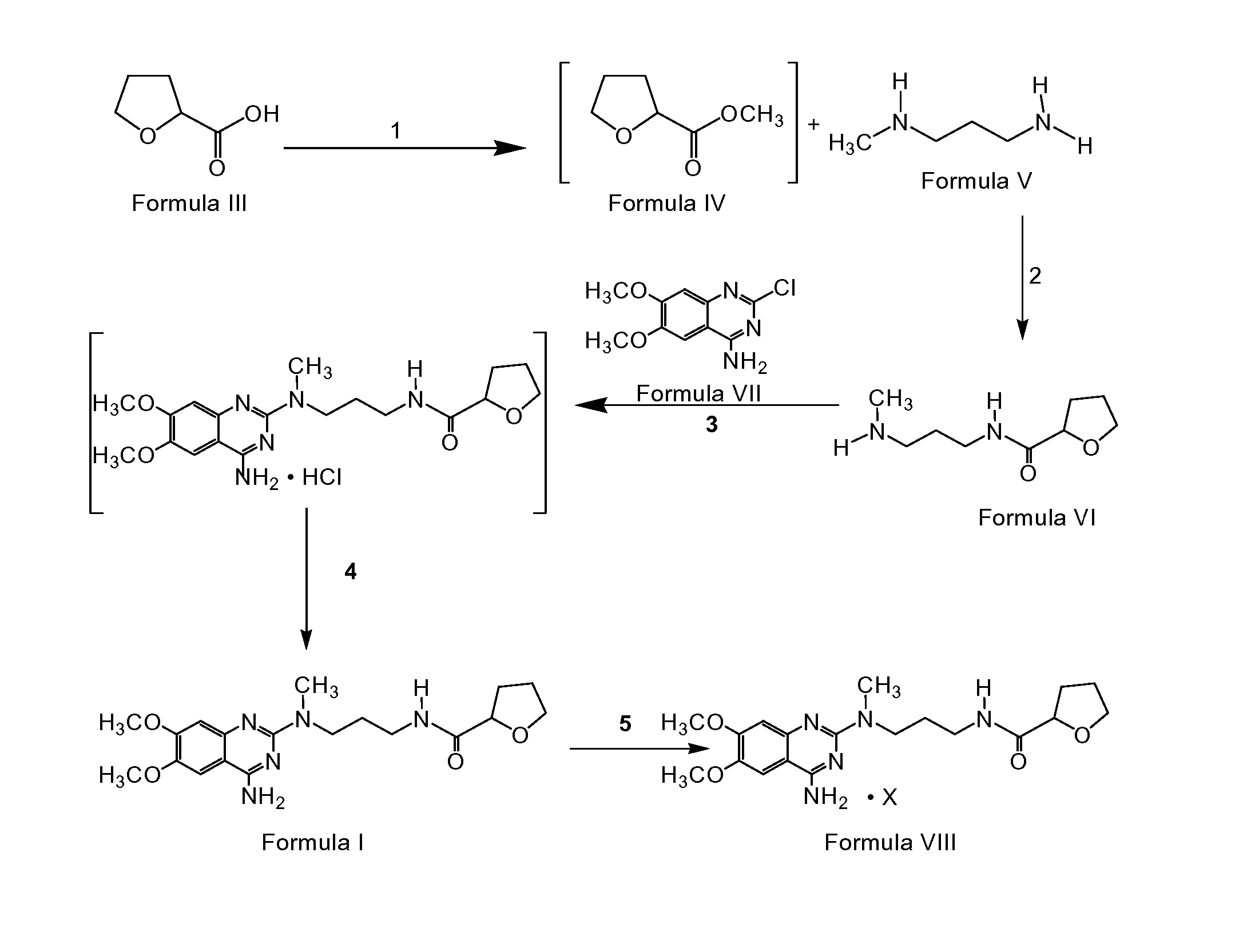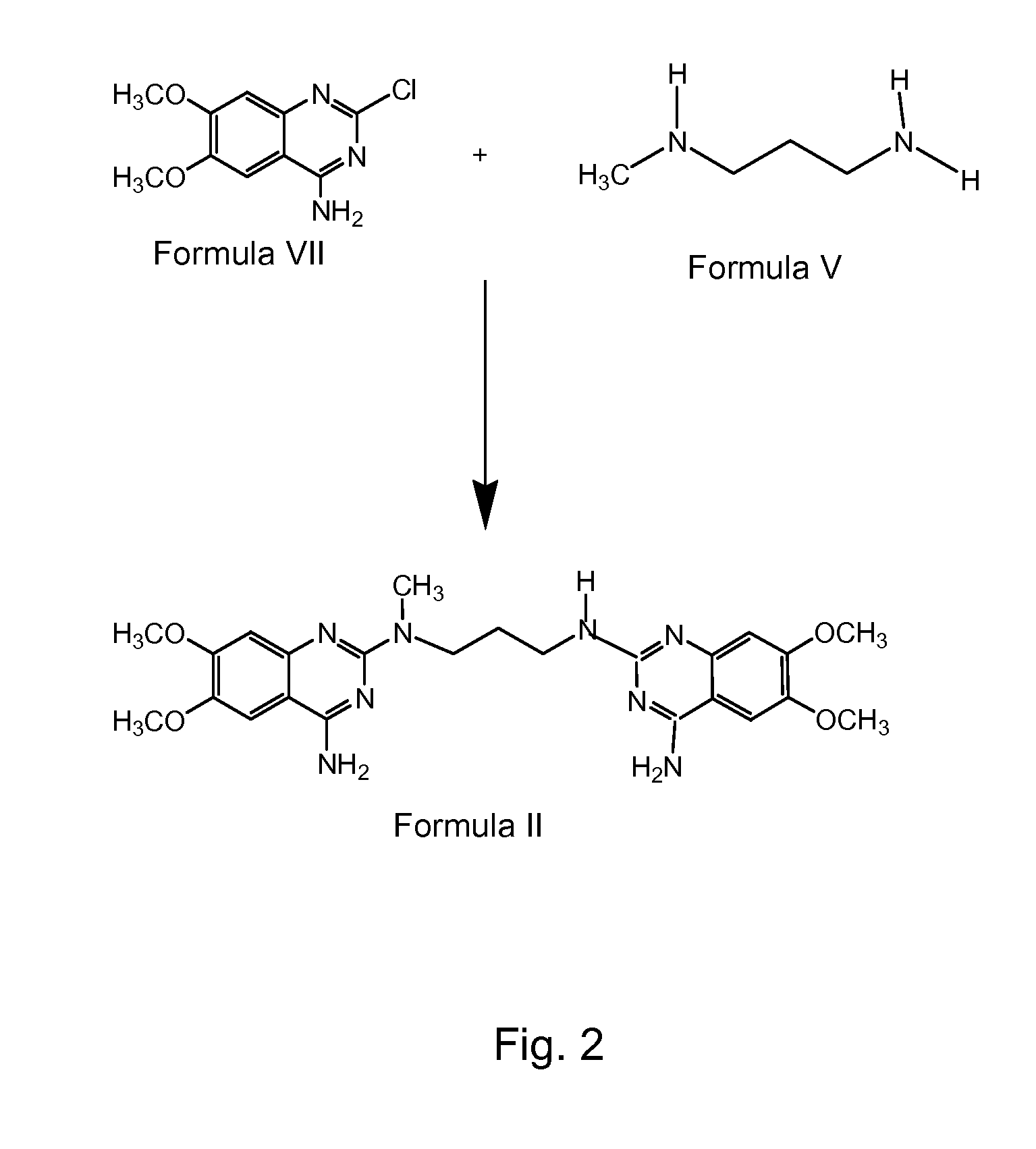Preparation of alfuzosin
a technology of alfuzosin and alfuzosin, which is applied in the field of process for the preparation of alfuzosin, can solve the problems of reducing the yield and purity of the obtained product, and none of the patents have identified the potential impurities obtained in their processes
- Summary
- Abstract
- Description
- Claims
- Application Information
AI Technical Summary
Benefits of technology
Problems solved by technology
Method used
Image
Examples
example 1
PREPARATION OF N1-METHYL-N2-TETRAHYDROFUROYLPROPYLENEDIAMINE (FORMULA V)
[0091] 45 liters of methanol was taken into a reactor and 4.5 kg of tetrahydrofuroic acid was added to it. 0.2 kg of sulfuric acid was added to the above mixture slowly at 28 ° C. The reaction mass was maintained at 30 ° C. for 5 hours. Reaction completion was checked using gas chromatography (“GC”). After the reaction was complete, the mass was transferred into another reactor and another 2 liters of methanol added to it. 3.42 kg of N-methyl-1,3-propanediamine was added to the reactor slowly at 30 ° C., then the mixture was heated to 42 ° C. and maintained for 30 hours. The reaction mass was cooled to 32 ° C. and maintained for 18 hours. Reaction completion was checked using GC. After the reaction was complete, the solvent was distilled off at 65 ° C. under atmospheric pressure. The residue was cooled to 28 ° C. and 24.8 liters of isopropyl alcohol was added to it. The mixture was stirred at 28 ° C. for 45 min...
example 2
PREPARATION OF PREPARATION OF N1-(4-AMINO-6,7-DIMETHOXYQUINAZOL-2-YL)-N1-METHYL-N2-(TETRAHYDROFURONYL-2)-PROPYLENEDIAMINE (FORMUL I)
[0092] 42 liters of isoamyl alcohol was taken into a reactor and 6.0 kg of 4-amino-2-chloro-6,7-dimethoxyquinozoline was added to it at 27 ° C. 5.59 kg of N1-(4-amino-6,7-dimethoxyquinazol-2-yl)-N1 -methyl-N2-(tetrahydrofuronyl-2)-propylenediamine was added to the same reactor at 27 ° C. Another 2 liters of isoamyl alcohol was added to it and the reaction mass was heated to 126 ° C. The mass was maintained at 126 to 128 ° C. for 22 hours. Reaction completion was checked using thin layer chromatography. After the reaction was complete, the mass was cooled to 48 ° C. and was maintained at 48 ° C. for 3 hours and then filtered at 47 ° C. The wet cake was washed with 6 liters of isoamyl alcohol. 90 liters of water was taken into another reactor and the wet cake was added to it. The mixture was stirred for dissolution, and then allowed to settle for separat...
example 3
PREPARATION OF N1-(4-AMINO-6, 7-DIMETHOXYQUINAZOL-2-YL)-N1-METHYL-N-2-(TETRAHYDROFUROYL-2)-PROPYLENEDIAMINE HYDROCHLORIDE (FORMULA VIII)
[0093] 45 liters of isopropyl alcohol was taken into a reactor and 4.5 kg of N1-(4-amino-6,7-dimethoxyquinazol-2-yl)-N1-methyl-N2-(tetrahydrofuronyl-2)-propylenediamine obtained above was added to it. 2.34 kg of isopropanolic hydrogen chloride (17.8%) was added to the mixture at 30 ° C. The reaction mass was stirred at 30 ° C. for 1.5 hours. The reaction mass was filtered and the wet cake was washed with 4.5 liters of isopropyl alcohol. The wet cake was dried initially at 57 ° C. and a vacuum of 600 mm Hg for 5 hours and then at 79 ° C. and 600 mm Hg for 18 hours to yield 4 kg of the title compound. (Yield 81.3%)
PUM
 Login to View More
Login to View More Abstract
Description
Claims
Application Information
 Login to View More
Login to View More - R&D
- Intellectual Property
- Life Sciences
- Materials
- Tech Scout
- Unparalleled Data Quality
- Higher Quality Content
- 60% Fewer Hallucinations
Browse by: Latest US Patents, China's latest patents, Technical Efficacy Thesaurus, Application Domain, Technology Topic, Popular Technical Reports.
© 2025 PatSnap. All rights reserved.Legal|Privacy policy|Modern Slavery Act Transparency Statement|Sitemap|About US| Contact US: help@patsnap.com



